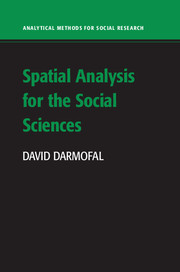Book contents
- Frontmatter
- Contents
- List of Figures
- List of Tables
- Preface
- PART I GENERAL TOPICS
- 1 The Social Sciences and Spatial Analysis
- 2 Defining Neighbors via a Spatial Weights Matrix
- 3 Spatial Autocorrelation and Statistical Inference
- 4 Diagnosing Spatial Dependence
- 5 Diagnosing Spatial Dependence in the Presence of Covariates
- 6 Spatial Lag and Spatial Error Models
- 7 Spatial Heterogeneity
- PART II ADVANCED TOPICS
- PART III APPENDICES ON IMPLEMENTING SPATIAL ANALYSES
- Glossary
- Bibliography
- Index
3 - Spatial Autocorrelation and Statistical Inference
from PART I - GENERAL TOPICS
Published online by Cambridge University Press: 05 November 2015
- Frontmatter
- Contents
- List of Figures
- List of Tables
- Preface
- PART I GENERAL TOPICS
- 1 The Social Sciences and Spatial Analysis
- 2 Defining Neighbors via a Spatial Weights Matrix
- 3 Spatial Autocorrelation and Statistical Inference
- 4 Diagnosing Spatial Dependence
- 5 Diagnosing Spatial Dependence in the Presence of Covariates
- 6 Spatial Lag and Spatial Error Models
- 7 Spatial Heterogeneity
- PART II ADVANCED TOPICS
- PART III APPENDICES ON IMPLEMENTING SPATIAL ANALYSES
- Glossary
- Bibliography
- Index
Summary
Once the researcher has determined the appropriate weights structure based on theoretical expectations, or estimated this structure from the data, her next step is to diagnose and model the spatial dependence in the data. Before examining how spatial autocorrelation is diagnosed (the subject of Chapter 4) and modeled (the subject of Chapter 5), it is important to examine first the substantive implications of spatial autocorrelation and the effects of this dependence on inference in the social sciences. Here, it is useful to return to Galton's problem, which was first presented in the introductory chapter of this book.
As Galton's problem recognizes, there are two principal sources of spatial dependence. The first is an explicitly spatial source, focused on behavioral diffusion. Spatial proximity promotes behavioral interaction; generally, units of interest in the social sciences, be they individuals, states, nation-states, or other units, are more likely to interact with each other if they are spatially proximate to each other. Spatial diffusion occurs when spatially proximate units are influenced directly by the behaviors of their neighbors, and vice versa. From a modeling perspective, positive spatial diffusion corresponds to a positive and significant parameter on a spatially lagged dependent variable, where neighbors are defined via a weights matrix such as those presented in Chapter 2.
Alternatively, neighboring units may share similar behaviors even if there is no behavioral interaction between these units. In this case, the units’ similarity in the behavior of interest is not affected directly by their neighbors’ behavior. Instead, neighboring units in this case share similar behaviors as a result of the geographic clustering of the sources of these behaviors. Such spatial dependence may be called attributional dependence because it is traced not directly to the behavior of neighboring units, but instead to shared attributes at neighboring locations. If we are unable to model fully the attributional sources of spatial dependence in the data generating process (DGP), these sources will produce spatial dependence in the error terms at neighboring locations. This spatial error dependence is modeled via a spatially lagged error term, where the error dependence is again modeled using a weights matrix such as presented in Chapter 2.
- Type
- Chapter
- Information
- Spatial Analysis for the Social Sciences , pp. 30 - 42Publisher: Cambridge University PressPrint publication year: 2015

